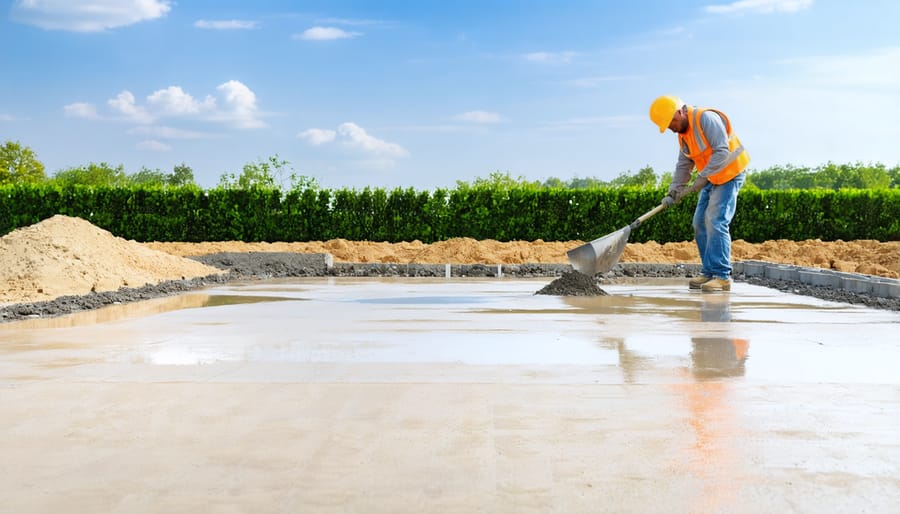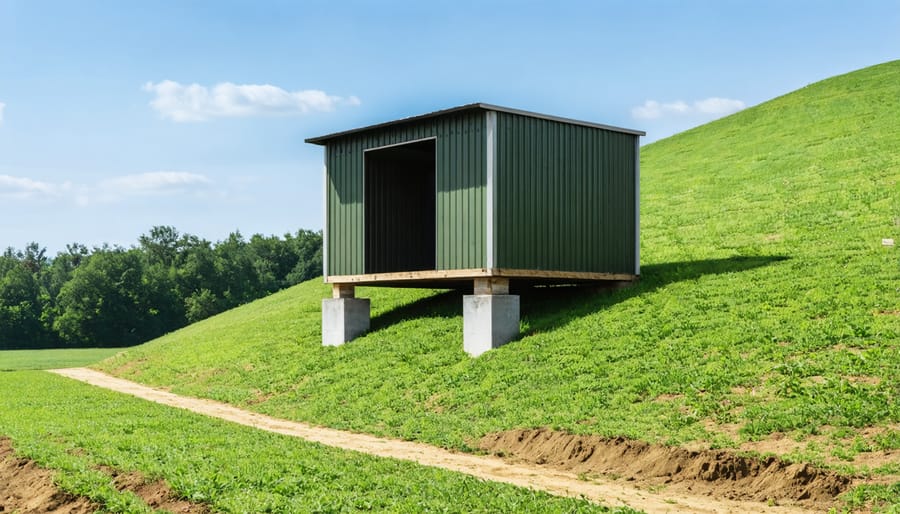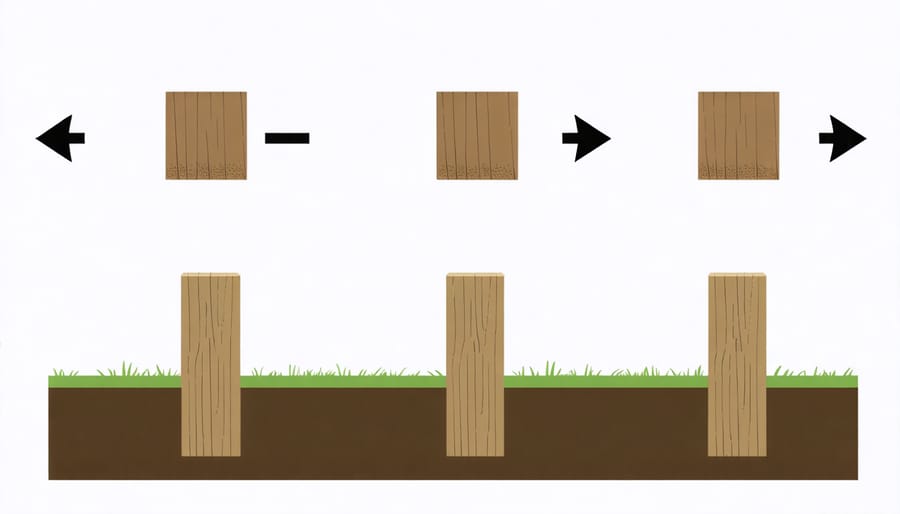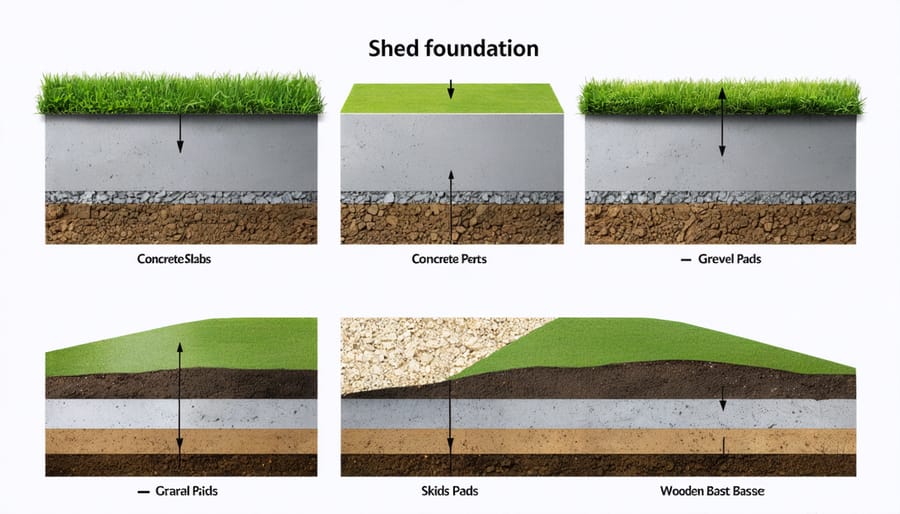Establish a solid, level base for your shed on uneven terrain with these expert tips:
Choose the best foundation for a shed considering your specific site conditions, budget, and skill level. Options include concrete slabs, gravel beds, wood platforms, and adjustable support systems.
Grade the ground to create a flat surface, removing high spots and filling in low areas. Use a laser level for precision.
Install the foundation, ensuring it’s square and level. Adjust for any remaining unevenness using shims, blocks, or specialized leveling jacks.
Anchor the shed securely to the foundation to prevent shifting or settling over time, especially in areas with frost heave or high winds.
Concrete Slab Foundation
Leveling and Preparing the Site
Before pouring a concrete slab, carefully level and prepare the ground. Start by removing any grass, rocks, or debris from the area. Next, use a leveling tool like a transit or laser level to determine the high and low spots. Excavate the high areas and fill in the low spots with compactable gravel or sand until the surface is even. Tamp down the gravel or sand to create a stable base. Install a perimeter form using 2×4 lumber to define the slab’s shape and size. Ensure the form is level and square. Finally, add a layer of compacted gravel inside the form to provide drainage and prevent settling. By taking the time to properly level and prepare the site, you’ll ensure a strong, durable foundation for your shed that will last for years to come.
Pouring and Finishing the Slab
Once the formwork is in place and leveled, it’s time to pour the concrete. Use a ready-mix concrete or mix your own according to manufacturer’s instructions. Pour the concrete evenly, starting from one corner and working your way across the slab. Use a straight board or screed to level the surface, moving it back and forth in a sawing motion. After screeding, use a bull float to further smooth the surface and push down any aggregate. Finally, use a hand float or trowel to achieve the desired finish, whether it’s a smooth or textured surface. Allow the concrete to cure fully before building your shed on top.


Concrete Pier Foundation
Positioning and Installing Piers
To position and install concrete piers on sloped ground, start by marking the locations for each pier according to your shed’s dimensions. Dig holes at each marked spot, making sure they are deep enough to reach stable soil and wide enough to accommodate the pier blocks. Place a layer of gravel at the bottom of each hole for drainage. Next, set the pier blocks into the holes, ensuring they are level with each other. This may require adjusting the depth of some holes or adding gravel beneath certain piers. Once all piers are level, fill the remaining space around them with soil, tamping it down firmly. With the piers securely in place, you’re ready to build your shed’s frame on this stable, customized foundation.
Attaching Shed to Piers
Once the piers are in place, secure the shed to them using metal brackets or straps. Ensure the brackets are properly anchored to both the piers and the shed’s floor joists for maximum stability. For added strength, consider using threaded rods embedded in the piers that extend up through the floor joists, secured with washers and nuts. This method provides a solid connection that can withstand the elements and keep your shed level for years to come.
Skid Foundation
When dealing with uneven ground, skids provide a simple and effective solution for your shed foundation. Skids, also known as runners or bearers, are pressure-treated timbers placed directly on the ground, allowing your shed to sit level even on sloped terrain. One significant advantage of using skids is their flexibility; they can be easily adjusted to accommodate varying heights and contours of the land. This adaptability ensures that your shed remains stable and avoids potential structural issues caused by an uneven base.
To install skids for your shed foundation, start by clearing and leveling the area as much as possible. Place the skids perpendicular to the slope, spacing them evenly to provide adequate support for your shed’s floor joists. If necessary, use concrete blocks or pressure-treated shims to level the skids and create a flat surface for your shed. When positioning the skids, make sure they extend slightly beyond the shed’s dimensions to prevent water from pooling around the base and causing moisture damage.
Skids offer a cost-effective and DIY-friendly option for shed foundations on uneven ground. With proper installation and leveling techniques, you can create a stable base that will protect your shed and its contents for years to come. So, if you’re looking for a practical solution to tackle that sloped backyard, consider using skids for your shed foundation.
Gravel Pad Foundation
A gravel pad is a cost-effective solution for creating a stable shed foundation on mildly uneven ground. To start, excavate the area to a depth of about 6 inches, ensuring it’s slightly larger than your shed’s footprint. Next, lay down a weed barrier or landscape fabric to prevent unwanted growth. Then, fill the excavated area with a 4-inch layer of crushed gravel, compacting it thoroughly with a plate compactor. Use a level to ensure the surface is even, adding or removing gravel as needed. Once level, add a final 2-inch layer of pea gravel for a smoother surface. This top layer also promotes drainage, helping to keep your shed’s foundation dry. A gravel pad is an excellent choice for those seeking a budget-friendly, DIY-friendly option that provides a stable base for your shed on slightly sloping ground. Plus, the natural appearance of gravel can blend seamlessly with your landscape design. Keep in mind that for more severe slopes or larger sheds, additional measures like retaining walls may be necessary to ensure long-term stability.
Wooden Post Foundation
Building a wooden post foundation is an effective way to create a sturdy base for your shed on uneven ground. Start by marking the shed’s corners and placing a post at each point, ensuring they’re plumb. Dig holes around 3 feet deep, or below the frost line in colder climates. Pour 6 inches of gravel into each hole for drainage, then place the posts and fill with concrete. Once set, cut the posts to the desired height, keeping the tops level. Attach pressure-treated lumber to the posts, creating a frame for your shed’s floor. Check that the frame is square and level, adjusting as needed. Finally, cover the frame with plywood or OSB, providing a solid surface for your shed. This method offers flexibility on uneven terrain and elevates your shed, preventing moisture damage. However, it requires more materials and time compared to other foundation types. With careful planning and execution, a wooden post foundation will provide a reliable base for your shed to withstand the elements and protect your belongings for years to come.

In conclusion, when building a shed on uneven ground, the best foundation option depends on your specific site conditions, budget, and skill level. A gravel pad is an affordable and DIY-friendly choice for minor slopes, while a concrete slab provides the most stability on moderately uneven terrain. For significantly sloped areas, consider a post and beam foundation or concrete piers. Whichever option you choose, ensure proper drainage, use pressure-treated lumber where applicable, and level the foundation as much as possible. By taking the time to select and install the right foundation, you’ll ensure your shed remains stable and functional for years to come. Remember, a solid foundation is crucial for any shed – but do you need a shed foundation in the first place? Assess your needs carefully before starting your project.





Leave a Reply